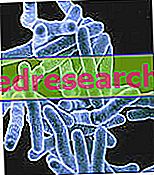Tuberculosis (TB) is an infectious and contagious disease - potentially serious - caused by the bacterium Mycobacterium tuberculosis or Koch's bacillus, named after the German doctor and bacteriologist who discovered it as far back as 1882.
Tuberculosis - which in most cases affects the lungs - is transmitted through droplets of saliva emitted by the patient during speech, coughing, spitting and sneezing. Fortunately, most people who come into contact with these germs do not develop symptoms of the disease, which is effectively turned off in the bud by the immune system.
Article index
Symptoms and complications of tuberculosis Risk factors Causes and contagion Tests and diagnosis of tuberculosis Cures and treatments Vaccination Tuberculosis drugs
Today, despite the significant pharmacological advances, tuberculosis remains one of the main causes of death worldwide, especially in the underdeveloped areas of the African and Asian continents. Tuberculosis kills about two million people each year, concentrated mainly in developing countries; WHO estimates that around one-third of the world's population is currently infected with TB.
The discovery of the first antitubercular drugs in the 40s, together with the improvement of the socio-sanitary conditions of the population, gave rise to rosy prospects for the eradication of tuberculosis. However, since 1980 the disease has experienced a resurgence, explainable - at least in part - with the global spread of AIDS, massive immigration from endemic areas and the emergence of strains resistant to pharmacological treatments. The latter can be eradicated only by resorting to a very expensive cocktail of drugs, to be taken for many months (18 and more) scrupulously respecting the medical indications; only by completing the therapeutic cycle is it possible to prevent the selection and spread of resistant microorganisms. Furthermore, regardless of the strain that caused tuberculosis, when antibiotic intake is not respected, the disease is likely to manifest again and people in the surrounding environment become infected.
In Italy, fortunately, the disease is characterized by a low incidence (less than 10 cases per 100, 000 inhabitants) and its spread is constantly monitored by health authorities.
Tuberculosis symptoms and complications
To learn more: Tuberculosis symptoms
As anticipated, around 90% of people who come into contact with tuberculosis bacilli heal forever without sequelae, and without needing to resort to any kind of therapy. For this reason, doctors distinguish so-called latent tuberculosis (or tuberculosis infection) from active tuberculosis (or tuberculosis). In the first case, the bacteria remain in the body in a latent state and the subject - in addition to not developing any symptoms - is not contagious; on the contrary, active tuberculosis is easily transmitted and often causes severe symptoms; among these we recall a rapid and inexplicable weight loss accompanied by fever, night sweats, chills, loss of appetite and a tendency to fatigue very easily. A whole series of pathological manifestations related to the interested body region, which usually is the pulmonary one, can also appear; in this case tuberculosis causes a continuous cough that lasts for several weeks accompanied by hemoptysis and chest pains when breathing or coughing.



